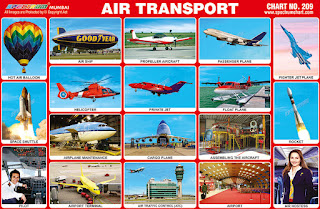Hot Air Balloon - Hot air
balloon is the first successful human-carrying flight technology. It
is lifted by heating the air inside the balloon, usually with fire.
The hot air inside the balloon has lower density than the air
outside, allowing it to rise and float in the air. People stand in a
basket that is under the balloon during flight. Hot air balloons are
used primarily for recreation today.
Space Shuttle - Space
Shuttle was a spacecraft which was used by the NASA. Space Shuttles
were used to carry astronauts and cargo into space. Cargo such as
satellites, parts of the International Space Station or scientific
instruments were taken up into space by the space shuttle.
Pilot - Pilot
is a person who actively and directly operates the directional
flight controls of an aircraft while it is in flight. Passenger
plane normally has 2 pilots in cockpit while in operation.
Air Ship – An airship is
a type of aerostat or lighter-than-air aircraft that can navigate
through the air under its own power. Aerostats gain their lift from
large gas bags filled with a lifting gas that is less dense than the
surrounding air. Airships were the first aircraft capable of
controlled powered flight, and were most commonly used before the
1940s.
Propeller Aircraft – A
propeller aircraft comprises a set of small, wing-like aerofoil
blades set around a central hub which spins on an axis aligned in
the direction of travel. The blades are set at a pitch angle to the
airflow, which may be fixed or variable, such that spinning the
propeller creates aerodynamic lift or thrust, in a forward
direction.
Passenger Plane - Passenger
planes are mostly used for carrying passengers from one place to
another. They are most common & widely used aircrafts.
Helicopter - A helicopter
is a kind of flying machine or aircraft. A helicopter lifts up off
of the ground and moves because of its rotors.
Private Jet - Private jet
is a jet aircraft designed for transporting small groups of people.
They may be adapted for other roles, such as the evacuation of
casualties or express parcel deliveries and some are used by public
bodies, government officials or the armed forces.
Float Plane – Float plane
is a type of seaplane, with one or more slender pontoons mounted
under the fuselage to provide buoyancy. It may also have landing
gear suitable for land, making the vehicle an amphibious aircraft.
Airplane Maintenance -
Aircraft maintenance is the overhaul, repair, inspection or
modification of an aircraft or aircraft component. The maintenance
of aircraft is highly regulated, in order to ensure safe and correct
functioning during flight. The maintenance tasks, personnel and
inspections are all tightly regulated and staff must be licensed for
the tasks they carry out.
Cargo Plane - Cargo
Aircraft is a fixed-wing aircraft that is designed for the carriage
of cargo rather than passengers. Aircraft designed for cargo flight
usually have a wide/tall fuselage cross-section, a high-wing to
allow the cargo area to sit near the ground, a large number of
wheels and a high-mounted tail to allow cargo to be driven directly
into and off the aircraft.
Assembling the Aircraft –
Aircraft assembling takes place in the manufacturing unit of
aircraft. Millions of parts are put together by various expert
technicians to complete the process of assembling of the aircraft.
Airport Terminal – An
airport terminal is a building at an airport where passengers
transfer between ground transportation and the facilities that allow
them to board and disembark from aircraft. Within the terminal,
passengers purchase tickets, transfer their luggage and go through
security checks. Smaller airports have one terminal while larger
airports have several terminals.
Air Traffic Control - Air
traffic control (ATC) is a service provided by ground-based
controllers who direct aircraft on the ground and in the air. The
primary purpose of ATC worldwide is to prevent collisions, organize
and expedite the flow of air traffic and provide information and
other support for pilots.
Airport - An airport is a
place where airplanes can land or take off. Most airports in the
world have only a long strip of level ground called a runway. Many
airports have buildings which are used to hold airplanes and
passengers.
Fighter Jet Plane - Fighter
jet planes are small military airplanes that are made to fight other
airplanes. They are often fast, having aerodynamic shapes and very
powerful engines for their size. Fighters can carry many different
kinds of weapons, including missiles, machine guns and bombs. While
fighters may be used as attack aircraft to attack vehicles, soldiers
or buildings on the ground.
Rocket - A rocket may be a
missile, spacecraft, aircraft or other vehicle which is pushed by a
rocket engine. Some rockets are manned & some unmanned to travel
in outer space.
Air Hostess - Air
Hostess are members of an aircrew employed by airlines primarily to
ensure the safety and comfort of passengers aboard commercial
flights & on select business jet aircraft. The number of flight
attendants required on flights are mandated by international safety
regulations.


No comments:
Post a Comment